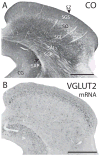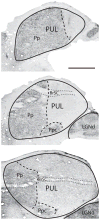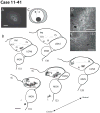Projections of the superior colliculus to the pulvinar in prosimian galagos (Otolemur garnettii) and VGLUT2 staining of the visual pulvinar
- PMID: 23124867
- PMCID: PMC3579010
- DOI: 10.1002/cne.23252
Projections of the superior colliculus to the pulvinar in prosimian galagos (Otolemur garnettii) and VGLUT2 staining of the visual pulvinar
Abstract
An understanding of the organization of the pulvinar complex in prosimian primates has been somewhat elusive due to the lack of clear architectonic divisions. In the current study we reveal features of the organization of the pulvinar complex in galagos by examining superior colliculus (SC) projections to this structure and comparing them with staining patterns of the vesicular glutamate transporter, VGLUT2. Cholera toxin subunit β (CTB), Fluoro-ruby (FR), and wheat germ agglutinin conjugated with horseradish peroxidase (WGA-HRP) were placed in topographically different locations within the SC. Our results showed multiple topographically organized patterns of projections from the SC to several divisions of the pulvinar complex. At least two topographically distributed projections were found within the lateral region of the pulvinar complex, and two less obvious topographical projection patterns were found within the caudomedial region, in zones that stain darkly for VGLUT2. The results, considered in relation to recent observations in tree shrews and squirrels, suggest that parts of the organizational scheme of the pulvinar complex in primates are present in rodents and other mammals.
Copyright © 2012 Wiley Periodicals, Inc.
Conflict of interest statement
The authors report no conflicts of interest
Figures










References
-
- Abramson BP, Chalupa LM. Multiple pathways from the superior colliculus to the extrageniculate visual thalamus of the cat. J Comp Neurol. 1988;271:397–418. - PubMed
-
- Adams MM, Patrick RH, Gattass R, Webster MJ, Ungerleider LG. Visual cortical projections and chemoarchitecture of macaque monkey pulvinar. J Comp Neurol. 2000;419:377–393. - PubMed
-
- Allman JM, Kaas JH, Lane RH, Miezin FM. A representation of the visual field in the inferior nucleus of the pulvinar in the owl monkey (Aotus trivirgatus) Brain Res. 1972;40:291–302. - PubMed
-
- Atencio FW, Diamond IT, Ward JP. Behavioral study of the visual cortex of galago senegalensis. J Comp Neurol. 1975;89:1109–35. - PubMed
Publication types
MeSH terms
Substances
Grants and funding
LinkOut - more resources
Full Text Sources
Other Literature Sources

